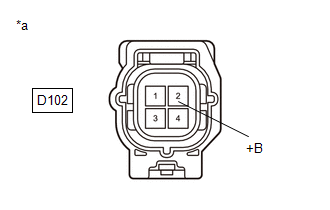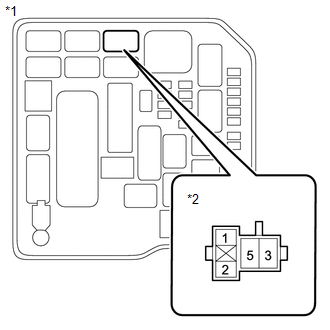Toyota Yaris: Sfi System / HO2S Heater Control Bank 1 Sensor 1 Circuit Short to Battery (P003012,P003013,P101A9E)
DESCRIPTION
The air fuel ratio sensor (sensor 1) generates current that corresponds to the actual air fuel ratio. This sensor current is used to provide the ECM with feedback so that it can control the air fuel ratio. The ECM determines the deviation from the stoichiometric air fuel ratio level, and regulates the fuel injection duration. If the air fuel ratio sensor (sensor 1) malfunctions, the ECM is unable to control the air fuel ratio accurately.
The air fuel ratio sensor (sensor 1) is a planar type sensor and integrated with the heater, which heats the solid electrolyte (zirconia element). This heater is controlled by the ECM. When the intake air volume is low (the exhaust gas temperature is low), a current flows into the heater to heat the sensor, in order to facilitate accurate oxygen concentration detection. In addition, the sensor and heater portions are a narrow type. The heat generated by the heater is conducted to the solid electrolyte through the alumina, and thereby sensor activation is accelerated.
In order to obtain a high purification rate of the carbon monoxide (CO), hydrocarbon (HC) and nitrogen oxide (NOx) components in the exhaust gas, a three-way catalytic converter is used. For the most efficient use of the three-way catalytic converter, the air fuel ratio must be precisely controlled so that it is always close to the stoichiometric level.
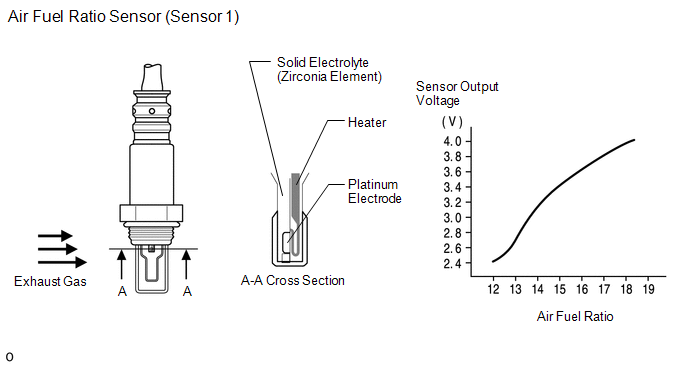
HINT:
- When any of these DTCs are stored, the ECM enters fail-safe mode. The ECM turns off the air fuel ratio sensor (sensor 1) heater in fail-safe mode. Fail-safe mode continues until the ignition switch is turned off.
- Although the DTC titles say oxygen sensor, these DTCs relate to the air fuel ratio sensor (sensor 1).
- The ECM has a pulse width modulated control circuit to adjust the current through the heater. The air fuel ratio sensor (sensor 1) heater circuit uses a relay on the +B side of the circuit.
| DTC No. | Detection Item | DTC Detection Condition | Trouble Area | MIL | Note |
|---|---|---|---|---|---|
| P003012 | HO2S Heater Control Bank 1 Sensor 1 Circuit Short to Battery | The air fuel ratio sensor (sensor 1) heater current is more than the specified value while the heater is operating (1 trip detection logic). |
| Comes on | SAE: P0032 |
| P003013 | HO2S Heater Control Bank 1 Sensor 1 Circuit Open | The air fuel ratio sensor (sensor 1) heater current is less than the specified value while the heater is operating (1 trip detection logic). |
| Comes on | SAE: P0031 |
| P101A9E | A/F Sensor Heater Performance Bank 1 Sensor 1 Stuck On | The air fuel ratio sensor (sensor 1) heater voltage level is low while the heater is not operating (1 trip detection logic). |
| Comes on | SAE: P101D |
MONITOR DESCRIPTION
The ECM uses information from the air fuel ratio sensor (sensor 1) to regulate the air fuel ratio and keep it close to the stoichiometric level. This maximizes the ability of the three-way catalytic converter to purify the exhaust gases.
The air fuel ratio sensor (sensor 1) detects oxygen levels in the exhaust gas and transmits the information to the ECM. The inner surface of the sensor element is exposed to the outside air. The outer surface of the sensor element is exposed to the exhaust gas. The sensor element is made of platinum-coated zirconia and includes an integrated heating element.
The zirconia element generates a small voltage when there is a large difference in the oxygen concentrations between the exhaust gas and outside air. The platinum coating amplifies this voltage generation.
The air fuel ratio sensor (sensor 1) is more efficient when heated. When the exhaust gas temperature is low, the sensor cannot generate useful current signals without supplementary heating. The ECM regulates the supplementary heating using a duty-cycle approach to adjust the average current in the sensor heater element. If the heater current is outside the normal range, the signal transmitted by the air fuel ratio sensor (sensor 1) becomes inaccurate. As a result, the ECM is unable to regulate the air fuel ratio properly.
When the current in the air fuel ratio sensor (sensor 1) heater is outside the normal operating range, the ECM interprets this as a malfunction in the sensor heater and stores a DTC.
MONITOR STRATEGY
| Frequency of Operation | Continuous |
TYPICAL ENABLING CONDITIONS
P0031| Output duty cycle | 7% or higher |
| Output duty cycle | 7% or higher |
| Output duty cycle | Less than 75% |
CONFIRMATION DRIVING PATTERN
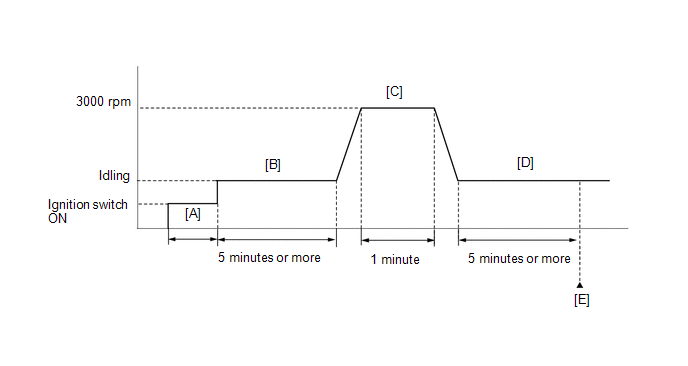
- Connect the GTS to the DLC3.
- Turn the ignition switch to ON.
- Turn the GTS on.
- Clear the DTCs (even if no DTCs are stored, perform the clear DTC procedure).
- Turn the ignition switch off and wait for at least 30 seconds.
- Turn the ignition switch to ON [A].
- Turn the GTS on.
- Start the engine and idle it for 5 minutes or more [B].
- With the vehicle stationary, depress the accelerator pedal and maintain an engine speed of 3000 rpm for 1 minute [C].
- Idle the engine for 5 minutes or more [D].
- Enter the following menus: Powertrain / Engine / Trouble Codes [E].
-
Read the pending DTCs.
HINT:
- If a pending DTC is output, the system is malfunctioning.
- If a pending DTC is not output, perform the following procedure.
- Enter the following menus: Powertrain / Engine / Utility / All Readiness.
- Input the DTC: P003012, P003013 or P101A9E.
-
Check the DTC judgment result.
GTS Display
Description
NORMAL
- DTC judgment completed
- System normal
ABNORMAL
- DTC judgment completed
- System abnormal
INCOMPLETE
- DTC judgment not completed
- Perform driving pattern after confirming DTC enabling conditions
HINT:
- If the judgment result is NORMAL, the system is normal.
- If the judgment result is ABNORMAL, the system has a malfunction.
- If the judgment result is INCOMPLETE, perform steps [B] through [E] again.
WIRING DIAGRAM
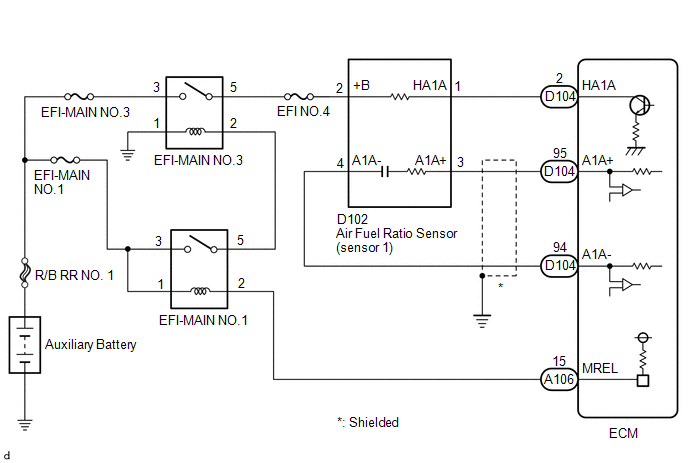
CAUTION / NOTICE / HINT
NOTICE:
Inspect the fuses for circuits related to this system before performing the following procedure.
HINT:
-
Refer to "Data List / Active Test" [A/F (O2) Sensor Heater Duty Ratio B1S1].
Click here

-
Change the fuel injection volume using the Control the Injection Volume for A/F Sensor function provided in the Active Test and monitor the air fuel ratio sensor (sensor 1) output current (Click here
 ). If the sensor output current does not change (almost no reaction) while performing the Active Test, the sensor may be malfunctioning.
). If the sensor output current does not change (almost no reaction) while performing the Active Test, the sensor may be malfunctioning.
- Read Freeze Frame Data using the GTS. The ECM records vehicle and driving condition information as Freeze Frame Data the moment a DTC is stored. When troubleshooting, Freeze Frame Data can help determine if the vehicle was moving or stationary, if the engine was warmed up or not, if the air fuel ratio was lean or rich, and other data from the time the malfunction occurred.
- Sensor 1 refers to the sensor closest to the engine assembly.
- Sensor 2 refers to the sensor farthest away from the engine assembly.
PROCEDURE
| 1. | INSPECT AIR FUEL RATIO SENSOR (SENSOR 1) (HEATER RESISTANCE) |
Click here

HINT:
Perform "Inspection After Repair" after replacing the air fuel ratio sensor (sensor 1).
Click here

| NG |
 | REPLACE AIR FUEL RATIO SENSOR (SENSOR 1) |
|
| 2. | CHECK TERMINAL VOLTAGE (POWER SOURCE OF AIR FUEL RATIO SENSOR (SENSOR 1)) |
(a) Disconnect the air fuel ratio sensor (sensor 1) connector.
(b) Turn the ignition switch to ON.
| (c) Measure the voltage according to the value(s) in the table below. Standard Voltage:
|
|
| NG |
 | GO TO STEP 6 |
|
| 3. | CHECK HARNESS AND CONNECTOR (AIR FUEL RATIO SENSOR (SENSOR 1) - ECM) |
(a) Disconnect the air fuel ratio sensor (sensor 1) connector.
(b) Disconnect the ECM connector.
(c) Measure the resistance according to the value(s) in the table below.
Standard Resistance:
| Tester Connection | Condition | Specified Condition |
|---|---|---|
| D102-1(HA1A) - D104-2(HA1A) | Always | Below 1 Ω |
| D102-1(HA1A) or D104-2(HA1A) - Body ground and other terminals | Always | 10 kΩ or higher |
| NG |
 | REPAIR OR REPLACE HARNESS OR CONNECTOR |
|
| 4. | CLEAR DTC |
(a) Clear the DTCs.
Powertrain > Engine > Clear DTCs(b) Turn the ignition switch off and wait for at least 30 seconds.
|
| 5. | CHECK WHETHER DTC OUTPUT RECURS (DTC P003012, P003013 OR P101A9E) |
(a) Drive the vehicle in accordance with the driving pattern described in Confirmation Driving Pattern.
(b) Read the DTCs.
Powertrain > Engine > Trouble Codes| Result | Proceed to |
|---|---|
| DTCs are not output | A |
| DTC P003012, P003013 or P101A9E is output | B |
| A |
 | CHECK FOR INTERMITTENT PROBLEMS |
| B |
 | REPLACE ECM |
| 6. | INSPECT EFI-MAIN NO.3 RELAY |
Click here

| NG |
 | REPLACE EFI-MAIN NO.3 RELAY |
|
| 7. | CHECK TERMINAL VOLTAGE (POWER SOURCE OF EFI-MAIN NO.3 RELAY) |
| (a) Remove the EFI-MAIN NO.3 relay from the No. 1 engine room relay block assembly. |
|
(b) Measure the voltage according to the value(s) in the table below.
Standard Voltage:
| Tester Connection | Condition | Specified Condition |
|---|---|---|
| 3(EFI-MAIN NO.3 relay) - Body ground | Always | 11 to 14 V |
| NG |
 | REPAIR OR REPLACE HARNESS OR CONNECTOR (AUXILIARY BATTERY - EFI-MAIN NO.3 RELAY) |
|
| 8. | CHECK HARNESS AND CONNECTOR (EFI-MAIN NO.3 RELAY - BODY GROUND) |
(a) Remove the EFI-MAIN NO.3 relay from the No. 1 engine room relay block assembly.
(b) Measure the resistance according to the value(s) in the table below.
Standard Resistance:
| Tester Connection | Condition | Specified Condition |
|---|---|---|
| 1(EFI-MAIN NO.3 relay) - Body ground | Always | Below 1 Ω |
| NG |
 | REPAIR OR REPLACE HARNESS OR CONNECTOR |
|
| 9. | CHECK HARNESS AND CONNECTOR (EFI-MAIN NO.3 RELAY - AIR FUEL RATIO SENSOR (SENSOR 1)) |
(a) Remove the EFI-MAIN NO.3 relay from the No. 1 engine room relay block assembly.
(b) Disconnect the air fuel ratio sensor (sensor 1) connector.
(c) Measure the resistance according to the value(s) in the table below.
Standard Resistance:
| Tester Connection | Condition | Specified Condition |
|---|---|---|
| 5(EFI-MAIN NO.3 relay) - D102-2(+B) | Always | Below 1 Ω |
| 5(EFI-MAIN NO.3 relay) or D102-2(+B) - Body ground and other terminals | Always | 10 kΩ or higher |
| OK |
 | REPAIR OR REPLACE HARNESS OR CONNECTOR (EFI-MAIN NO. 1 RELAY - EFI-MAIN NO.3 RELAY) |
| NG |
 | REPAIR OR REPLACE HARNESS OR CONNECTOR |
 Crankshaft Position - Camshaft Position Correlation Bank 1 Sensor A (P001600,P001700)
Crankshaft Position - Camshaft Position Correlation Bank 1 Sensor A (P001600,P001700)
DESCRIPTION In the VVT (Variable Valve Timing) system, the appropriate intake and exhaust valve open and close timing is controlled by the ECM. The ECM performs intake and exhaust valve control by performing the following: 1) controlling the camshaft, cam timing oil control solenoid assembly, camshaft timing gear bolt (camshaft timing oil control valve) and operating the camshaft timing gear; and 2) changing the relative positions of the camshaft and crankshaft...
 Turbocharger / Supercharger Bypass Valve "A" Control Circuit Short to Battery (P003312)
Turbocharger / Supercharger Bypass Valve "A" Control Circuit Short to Battery (P003312)
DESCRIPTION The air by-pass valve assembly is installed in the air outlet duct. It opens and closes in response to drive commands from the ECM. During normal boosting, the air by-pass valve assembly is closed, and when the throttle valve is closed while the boost pressure is applied, the air by-pass valve assembly opens and the excess pressure between the turbocharger and throttle valve is released to prevent the surge phenomenon*...
Other information:
Toyota Yaris XP210 (2020-2024) Reapir and Service Manual: Precaution
PRECAUTION CAUTION REGARDING INTERFERENCE WITH ELECTRONIC DEVICES CAUTION: As weak radio waves are emitted from the electrical key transmitter sub-assembly, if a pacemaker is being used, be sure to read the pacemaker instruction manual and the following...
Toyota Yaris XP210 (2020-2024) Reapir and Service Manual: Analog to Digital Converter Circuit Voltage Out of Range (P060B1C,P060B49,P060B71)
DESCRIPTION If an internal malfunction occurs in the engine stop and start ECU, it stores P060B1C, P060B49 or P060B71 and blinks the stop and start cancel indicator. DTC No. Detection Item DTC Detection Condition Trouble Area Warning Indicate Memory Note P060B1C Analog to Digital Converter Circuit Voltage Out of Range Both of the following conditions are met for 0...
Categories
- Manuals Home
- Toyota Yaris Owners Manual
- Toyota Yaris Service Manual
- How to use USB mode
- Adjustment
- How to connect USB port/Auxiliary jack
- New on site
- Most important about car
Supplemental Restraint System (SRS) Precautions
The front and side supplemental restraint systems (SRS) include different types of air bags. Please verify the different types of air bags which are equipped on your vehicle by locating the “SRS AIRBAG” location indicators. These indicators are visible in the area where the air bags are installed.
The air bags are installed in the following locations:
The steering wheel hub (driver air bag) The front passenger dashboard (front passenger air bag) The outboard sides of the front seatbacks (side air bags) The front and rear window pillars, and the roof edge along both sides (curtain air bags)

